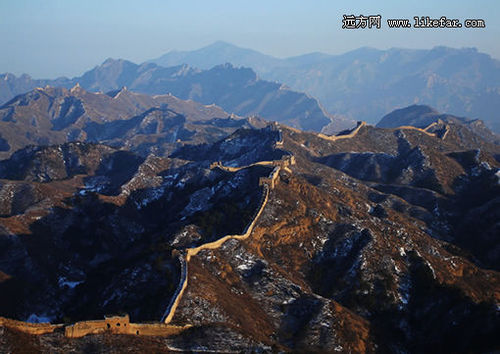 |
|
Gubeikou Great Wall [Photo/likefar.com]
|
Gubeikou is one of the many passes of the world famous Great Wall of China. As an ancient battlefield that has witnessed over 130 wars in history, the Gubeikou Great Wall sits like a battle-hardened general on the ridge of Yanshan Mountain north of Beijing. Even a glimpse of it from afar fills one with awe. In fact its imposing manner has attracted many Chinese history enthusiasts to hunt for traces of antiquity here, the most northeastern point of Beijing.
Gubeikou Town is located in the northeastern part of Miyun County, about 100 kilometers from downtown Beijing. It was an important passage between the Shanhai and Juyong passes, as well as a vital channel for exchanges between Beijing and Northeast China, a location that gives it great military significance.
I often think that among the countless watchtowers along the Great Wall, those on the Gubeikou section bear the brightest torch of Chinese history: The area, at the gateway of Beijing, has witnessed many of the most significant historical events of the country. Even today, some locals believe they can hear the battle cries of warriors at night in the deep mountains of Gubeikou.
Bullets in the Wall
When I arrived at the Gubeikou Great Wall, my guide Mr. Pang was waiting for me under the memorial archway in the town. Pang has a deep understanding of local culture in Gubeikou and the history of the Great Wall. As a result he was headhunted to work for the town’s government. One of his responsibilities is to put on movies for rural residents.
In my childhood memories, watching movies in outdoor theaters was a sacred event in rural communities. In an open field filled with the sounds of frogs croaking and crickets chirping, the images of beautiful stories were transported from film to screen at the hands of one person, the projectionist.
Of course, alongside the diversification of entertainment forms, playing movies in rural areas attracts less and less people these days. However, that doesn’t affect Pang’s passion for his job. Because in such a tranquil town surrounded by the Great Wall, the scenarios in some movies will magically interweave with the local environment. The ancient battlefields come to life. War and fire, soul and flesh, love and hate – such a montage of today’s world and history is unlikely to be felt in any city theaters.
I accompanied Pang on his rounds of showing movies in local villages. Most of those he screened were old war films that I remember seeing as a child, and some newer children’s movies such as Shrek. But for me, the films he projected were not the main event – after the crowds had left, Pang used his very old projector to show me some fascinating old photos.
The pictures were mostly authentic records by international journalists taken during the combat against Japanese aggression at Gubeikou in 1933. They depicted the most horrifying and sad moments of the war and it was hard to imagine how those international war correspondents were able to capture such images under such harsh conditions.
We Recommend:
